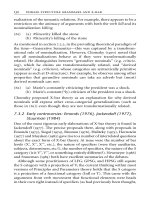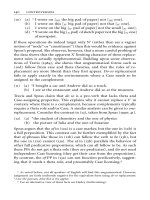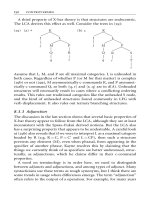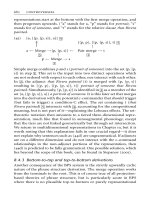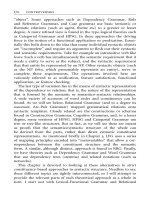Tài liệu Constituent Structure - Part 28 pdf
Bạn đang xem bản rút gọn của tài liệu. Xem và tải ngay bản đầy đủ của tài liệu tại đây (122.07 KB, 10 trang )
Instead, following Ura (1994), he claims that TP and vP should allow
multiple speciWers (by this, he actually means Chomsky-adjoined struc-
tures) and these heads serve the purpose of AgrS and AgrO, respectively.
AgrPs are widely absent from the current minimalist literature. I per-
sonally think this is a mistake. Although the original motivations for
two AgrPs were weak (in Chomsky 1993 they were purely conceptual),
subsequent work has shown that they can account for a wide variety of
agreement particles (such as the AgrO particle in Irish). Sportiche
(1996) also showed they were an important mechanism for explaining
the properties of Romance pronominal clitics. While it is true that the
Agrs have no clear function in the LF, they do have such a function at
the other interface (PF). One might counter Chomsky’s objections to
the Agr categories by claiming that items in the tree must have an
interpretation at either of the two interfaces, in which case AgrPs can
be construed as legitimate objects.
A number of other functional projections in the clausal layer have
been proposed. Beghelli (1995) and Beghelli and Stowell (1997) put-
forth three new functional categories (DistP, ShareP, and RefP) to
account for scope ambiguity among quantiWed DPs. Roberts (2005)
proposes splitting AgrPs into PersP (person) and NumP (Number) on
the basis of data from Welsh and various Italian dialects. Cardinaletti
(2004) suggests that in addition to AgrP and TP, two other subject
related functional categories are required: SubjP hosts ‘‘subject of
predication’’ arguments and EPPP hosts arguments that satisfy EPP
eVects. Spencer (1992) proposes the Full Functional Projection Hy-
pothesis,32 which argues that each feature associated with the verbal
projection gets its own functional projection. This idea is echoed more
recently in the work of Kayne (2005), who claims that all variation is
ultimately controlled by microparameters, each associated with a par-
ticular functional category and every functional element is the locus
of some distinct parametric variation. Behind this proposal is the
idea that parametric variation has to do with the pronunciation or
non-pronunciation of a wide variety of functional items.
11.5 The informational layer
The informational layer contains constituent structure associated with
Wniteness, illocutionary force, negation, mood, and topic and focus
32 See also Mohr (2005).
250 controversies
structures. I will start with the arguments that distinguish an unheaded
S’ analysis from a CP structure, with some pointers to other ap-
proaches. Then I will turn to the internal structure of CPs to discuss
the evidence that CP should be expanded into several diVerent cat-
egories the way IP expanded into TP and AgrPs.
11.5.1 S’ and CP33
In the 1960s and 1970s, the structure that provided means of subor-
dinating one clause into another was the S’, which had S and Comp
(complementizer) daughters:
()SЈ
Comp S
…
LikeS,S’ was often viewed as a projection or extended projection of the
V head. Bresnan (1972) provides the Wrst detailed probe into the nature
of complementizers and their grammatical function and suggested that
Comp (later shortened to C) was the head of the S’ category. The
argument came from the fact that various verbs select for the form of
the complementizer that follows. For example, a verb like ask allows an
if complementizer, but a verb like think does not. Grimshaw (1977)
argues that the selectional restrictions of this type are for the logical
type of the sentence rather than the form of the complementizers.
Stowell (1981) provides extensive evidence in favor of the idea that C is
the head of S’ from Case theory. See Fassi-Fehri (1981), Koopman
(1984), and Chomsky (1986a) for apparently independent proposals
to implement the headedness of C into X-bar theoretic terms giving
the CP category; see Pollard and Sag (1994) for arguments34 that C is
not the head of CP.
33 Thanks to Anne Abeille
´
, John Beavers, Bob Borsley, Aaron Broadwell, Stan Dubinsky,
David Pesetsky, and Steven Weschler for helping me track down the origins of the CP analysis.
34 Pollard and Sag point out that verbs like demand select bare verbs:
(i) I demand that he leave (*leaves).
If C is the head of the embedded clause then we have no means of doing local selection for the
form of the verb. But if the V is the head of S’ then demand can select a bare form of the verb.
There is, however, an easy way around this in the C-as-head theory. English must have two
thats; one is for declarative contexts, the other for subjunctives. Demand selects the subjective
that, which in turn selects a defective IP, which triggers the bare form of the verb.
phrasal categories and cartography 251
Beyond selection for a particular type of C, there is evidence from a
variety of constructions that point towards an X-bar-theoretic CP. The
structure of wh-questions is a good starting point. Early characteriza-
tions of wh-movement suggested moving the wh-phrase into the
Comp position itself (see for example Ross 1967). There are several
reasons to be suspicious of this account. First, it implies the idea that
Comp is a position in the tree rather than a word or head; for example,
we can move quite a complex phrase to the beginning of the sentence:
(57) [Which Pictures of Bill] did Susan like?
Movement of a phrase into a head is unusual (see, however, the discus-
sion of Carnie 1995 in Ch. 8). Second, the position of the inverted
auxiliary in these questions is quite mysterious. In the CP analysis, by
contrast, a straightforward analysis of these facts is available. Wh-phrases
appear in a speciWer position—speciWers typically being Wlled by phrases,
and the inverted auxiliary appears in the C head itself. The wh-movement
is triggered by a wh-feature on the C, the head movement is motivated by
a[þQ] feature on the C.35 (For a very diVerent view of subject–aux
inversion, see the literature from GPSG including GKPS.)
()CP
NP CЈ
wh C+T
did
TP
A similar account can be given to the discourse-related V2 eVects in
languages like German. In tensed clauses without an overt comple-
mentizer, the verb must appear in ‘‘second position’’. The Wrst position
in the sentence is occupied by a topicalized constituent. In example
(58) (data from Haegeman 1994), the verb kaufte always appears in the
second position, and any of the other elements (the subject Karl, the
object dieses Buch, or the temporal adverb gestern) can appear in
the Wrst position. The remaining constituents follow the verb.
(59) (a) Karl kaufte gestern dieses Buch.
Karl bought yesterday this book
‘‘Karl bought this book yesterday.’’
35 The [þQ] complementizer is realized by particles in many languages including
Japanese and Irish.
252 controversies
(b) Dieses Buch kaufte Karl gestern.
‘‘Karl bought this book yesterday.’’
(c) Gestern kaufte Karl dieses Buch.
‘‘Karl bought this book yesterday.’’
In clauses with overt complementizers, by contrast, there is no V2
ordering. The verb appears in Wnal position:
(60) Ich dachte daß Karl gestern das Buch gekauft hat.
I thought that Karl yesterday the book bought has
‘‘I thought that Karl bought the book yesterday.’’
The standard analysis within the P&P framework (den Besten 1981;
Taraldsen 1985; Thra
´
insson 1985; Platzack 1986a, b, 1987, 1995; Schwartz
and Vikner 1989, 1996) holds that there is a requirement that the
complementizer position be Wlled in tensed clauses. The verb raises
to the empty complementizer position in matrix clauses via InX. There
is then an additional requirement that the speciWer of a matrix com-
plementizer be Wlled by some element, giving the V2 order.
()CP
topic CЈ
CIP
IЈ
Infl VP
V
In embedded clauses, however, the complementizer position is Wlled,
and the verb cannot raise to it. Simultaneously, the requirement that
Spec of CP be Wlled by some XP is removed. Thus V2 ordering is
blocked. Carnie, Pyatt, and Harley (1994) and Carnie, Harley, and
Pyatt (2000) propose a similar analysis for Old Irish.
11.5.2 Expanded CP
Rizzi (1997) argues that the left edge of the clause (i.e. the CP system) is
more Wnely grained than a single projection.36 In this, he follows some
36 See Iatridou and Kroch (1992) for earlier arguments that clauses have multiple CPs
stacked on top of them.
phrasal categories and cartography 253
earlier work that proposed MoodP (Zanuttini 1997) and Polarity (Culi-
cover 1991; Laka 1991; Branigan 1992); we will return to the latter brieXy
below in section 11.7. Rizzi argues that on the inside of the CP system
we have a functional head that represents Wniteness. Finiteness is not
tense, but has temporal properties; for example, many languages have
Wniteness particles that depend partly on the tense system for their
form, but do not express the full range of tense morphology found on
verbs. On the outside edge of the CP system, we have a category that
represents illocutionary force (is the sentence a proposition, an
interrogative, a command, or, alternatively, is it a declarative clause, a
question, or an imperative?). Between the two, Rizzi argues for three
positions directly tied to the information structure of the clause. In
the very middle is a focus position, which is associated with new
information in the clause. Straddling this focus position are two
positions associated with old information or topics. This gives rise to
the structure in (62)
(62)[
ForceP
Force [
TopP
Top [
FocP
Foc [
TopP
Top [
FinP
Fin [
TP
...
Rizzi presents evidence from the positioning of topics, focus, inverted
auxiliaries, adverbials, and complementizers in Italian and English.
The results also provide an interesting account of some mysterious
adverbial eVects in Irish. McCloskey observes that the order of adver-
bial elements and complementizers in English is diVerent in embedded
and matrix contexts.
(63) (a) I said next Christmas that we should see Frank (*interpret-
ation where the seeing occurs next Christmas. Only a matrix
interpretation is allowed
(b) Next Christmas, who should we see? (next Christmas can be
interpreted with see)
In Irish, surprisingly, the order of adverbials and complementizers is
diVerent. Adverbials appear to the left of both complementizers and
subjects in both matrix and embedded CPs (data from McCloskey
1996a):
(64) Adverb C V
Lı
´
onaim d’eagla da
´
dto
´
gfainn mo radharc do
´
ibh go dtitWnn.
Wll.1s of fear if lift-1s.cond my sight from.3s that fall.1s
‘‘I Wll up with fear that, were I to take my eyes oV, then
I would fall.’’
254 controversies





